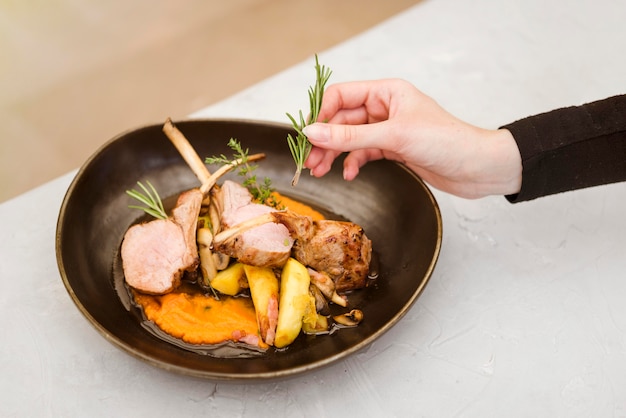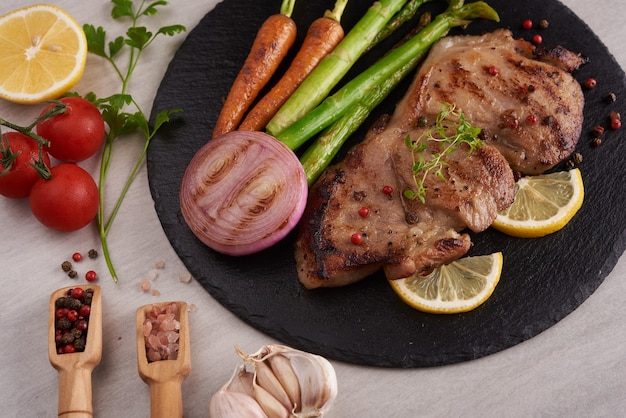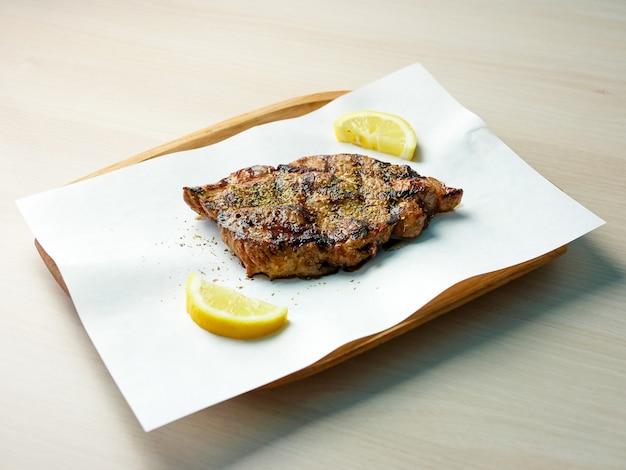Let's face it, pork chops are a classic for a reason. They're versatile, affordable, and can be whipped up into a delicious meal in no time. But let's be honest, we've all had those disappointing experiences with dry, tough pork chops that left us wondering what went wrong. Well, worry no more! This comprehensive guide is packed with tips and tricks to help you cook perfect, juicy, and flavorful pork chops every single time.
(Part 1) Choosing the Right Pork Chops - A Foundation for Flavor

Choosing the right pork chops is the first step on your journey to culinary success. It's like picking the perfect ingredients for your favourite dish; it sets the stage for flavour and texture. Here's a breakdown of what to look for:
Knowing Your Pork: Boneless, Bone-in, and Center-Cut
Boneless: These chops are generally thinner and cook faster. They're great for quick weeknight meals or pan-frying.
Bone-in: A bit thicker, they take a little longer to cook but hold onto moisture better. I personally love bone-in chops because they tend to have more flavour and a more rustic feel.
Center-cut: These are the most tender cuts from the loin, known for their exceptional juiciness.
Thickness: A Key Factor in cooking time
The thickness of your pork chops directly impacts how long they need to cook.
Pan-frying: Aim for chops that are about 1 inch thick for a nice sear and even cooking.
Grilling: Go for a bit thicker, around 1.5 inches, for a more substantial bite.
Thin chops: These are best suited for quick cooking methods like stir-fries.
Fat is Your Friend: Embrace the Marbling
Don't be afraid of fat! It plays a crucial role in keeping your pork chops moist and flavorful. Look for chops with a decent amount of marbling, which is the fat that's naturally interwoven within the meat. It adds richness and juiciness that you don't want to miss.
(Part 2) Prepping for Perfection: Getting Ready to Cook

Once you've chosen your perfect pork chops, it's time to get them ready for cooking. A little prep work goes a long way in ensuring a delicious result.
Pat it Dry: The Importance of Moisture Control
Start by patting your pork chops dry with paper towels. This may seem like a small step, but it makes a big difference. Removing excess moisture prevents steam from forming during cooking, which can lead to a soggy, less flavorful chop.
Seasoning: A Symphony of Flavors
Now for the fun part: seasoning! You can keep things simple with just salt and pepper, or get creative with a mix of herbs and spices. My go-to is a blend of salt, pepper, paprika, and garlic powder. It's a classic combination that enhances the natural pork flavour without overpowering it.
Brining: The Secret to Juicy Results
Brining is a technique that involves soaking your pork chops in a salt water solution, which draws moisture into the meat, resulting in incredibly juicy and tender results. While I used to be hesitant, I've learned to appreciate the benefits of brining, especially for thicker, bone-in chops.
(Part 3) Pan-Frying: Searing the Way to Success

Pan-frying is a fantastic method for creating a crispy crust on your pork chops, locking in those delicious juices. It's a technique that works for any skill level, and it's a great way to impress even the pickiest eaters.
The Right Pan: The Foundation of Success
Choose a heavy-bottomed pan, like cast iron or stainless steel, for even heat distribution. Heat it over medium-high heat, letting it get nice and hot before adding your pork chops.
Oil is Key: A Lubricant for Flavor
Add a small amount of oil to the pan, just enough to coat the bottom. Neutral oils like vegetable or canola oil work well, but olive oil can also be used, just be careful not to let it burn.
Searing: Creating a Golden Crust
Now it's time to sear! Carefully place your pork chops in the hot pan, ensuring they have space to cook evenly. Let them cook for 3-4 minutes per side, without moving them around too much. You're aiming for a beautiful golden brown crust that signals perfectly seared deliciousness.
Flipping and Finishing: Cooking to Perfection
Carefully flip the chops over and continue cooking for another 3-4 minutes, or until they reach an internal temperature of 145°F. Using a meat thermometer is the most accurate way to ensure they're cooked through.
(Part 4) Grilling: Embracing the Smoky Flavors
grilling pork chops takes them to a whole new level, adding a smoky depth of flavour that's hard to resist. It's perfect for summertime meals and entertaining.
Grill Prep: Getting Ready for the Grill
Clean your grill grate thoroughly to ensure your chops don't stick. Heat it up to medium-high heat, letting it get nice and hot before placing your pork chops on the grill.
Grilling Time: Mastering the Heat
Place your seasoned chops on the grill and cook them for 5-6 minutes per side, or until they reach an internal temperature of 145°F. Remember to flip them halfway through to ensure even cooking.
The Art of Resting: Unlocking Juicy Results
Once the chops are cooked, don't rush to slice and serve them. Instead, let them rest for 5-10 minutes. This allows the juices to redistribute throughout the meat, resulting in a much more tender and juicy chop.
(Part 5) Baking: A Hands-Off Approach to Deliciousness
Baking pork chops in the oven is a great option for a more hands-off approach, perfect for busy evenings. It's a simple method that delivers consistently delicious results.
Oven Pre-Heating: Setting the Stage for Even Cooking
Preheat your oven to 375°F (190°C). This ensures that your chops cook evenly from the inside out.
Grease it Up: Preventing Sticking
Grease a baking sheet with a little bit of oil or cooking spray. This helps prevent your chops from sticking to the pan. Place your seasoned pork chops on the sheet, ensuring they have space to cook evenly.
Bake Time: Achieving Tender Perfection
Bake your chops for 20-25 minutes, or until they reach an internal temperature of 145°F. Use a meat thermometer to check for doneness.
(Part 6) Going Beyond the Basics: Elevate Your Pork Chop Game
Once you've mastered the fundamentals of cooking pork chops, it's time to explore the possibilities of sauces, glazes, and side dishes that can elevate your meal to the next level.
Sauces and Glazes: Adding Layers of Flavor
A simple pan sauce made with butter, wine, and herbs can add a touch of sophistication to your pork chops. Or, if you're feeling adventurous, try a glaze, like honey-soy, maple-bourbon, or even a smoky barbecue sauce.
The Power of Herbs: Enhancing the Pork's Natural Flavor
Fresh herbs like rosemary, thyme, and sage complement pork beautifully. You can incorporate them into your seasoning mix, add them to a pan sauce, or even use them as a garnish.
Side Dishes: A Symphony of Textures and Flavors
Consider side dishes that complement the flavour and texture of your pork chops. Roasted vegetables, creamy mashed potatoes, polenta, and a refreshing green salad are all excellent options.
(Part 7) Don't Fear the Doneness: Mastering the Art of Cooking Pork
One of the most crucial aspects of cooking pork chops is ensuring they're cooked through to the recommended internal temperature of 145°F. This is essential for food safety and prevents the risk of foodborne illness.
Internal Temperature: The Gold Standard
Using a meat thermometer is the most reliable way to check the internal temperature of your pork chops. It's a small investment that can make a big difference in your cooking confidence.
Visual Cues: Identifying Doneness
If you don't have a meat thermometer, here are some visual cues to help you gauge doneness:
Colour: The pork will turn from pink to a light brown or grey colour when it's cooked through.
Texture: The pork will feel firm to the touch.
Juices: When you cut into the chop, the juices should run clear, not pink.
Safety First: A Reminder of Food Safety
Remember, it's always better to err on the side of caution and cook your pork chops to the recommended temperature. Undercooked pork can be dangerous, so don't hesitate to double-check with a meat thermometer.
(Part 8) FAQs: Answers to Your Pork Chop Questions
1. Can I cook pork chops from frozen?
While you can technically cook frozen pork chops, it will take longer and might result in uneven cooking. It's best to thaw them in the refrigerator overnight before cooking for the best results.
2. What if my pork chops are too thin?
For thin pork chops, try quick cooking methods like pan-frying or using them in a stir-fry. Just make sure they're cooked through!
3. What can I do with leftover pork chops?
Leftover pork chops are a great opportunity for a delicious meal! Slice them up and add them to a salad, make a pork chop sandwich, or even use them in a pasta dish.
4. How do I know if my pork chop is cooked through?
The best way to check is by inserting a meat thermometer into the thickest part of the chop. It should reach an internal temperature of 145°F.
5. How long should I let my pork chops rest after cooking?
Let them rest for 5-10 minutes before slicing and serving. This allows the juices to redistribute, resulting in a more tender and juicy chop.
(Part 9) A Final Word: Embrace the Deliciousness of Pork Chops
Cooking perfect pork chops is an achievable goal, even if you're not a seasoned chef. By following these tips and tricks, you can enjoy consistently delicious, juicy, and flavorful results. So go on, embrace the deliciousness of pork chops, and let your culinary creativity shine!
| Cooking Method | Time (minutes) | Internal Temperature (°F) | Doneness |
|---|---|---|---|
| Pan-frying | 6-8 | 145 | Medium |
| Grilling | 10-12 | 145 | Medium |
| Baking | 20-25 | 145 | Medium |
Everyone is watching

Prime Rib Roast Cooking Time Chart: Per Pound Guide
Cooking TipsPrime rib roast. Just the name conjures images of lavish dinners, crackling fires, and hearty laughter. It’s ...

How Long to Bake Potatoes in the Oven (Perfect Every Time)
Cooking TipsBaked potatoes are a staple in my kitchen. They're incredibly versatile, delicious, and surprisingly easy to m...

Perfect Rice Every Time: The Ultimate Guide to Cooking Rice
Cooking TipsAs a self-proclaimed foodie, I've always been a bit obsessed with rice. It's the foundation of countless cuisi...

The Ultimate Guide to Cooking Asparagus: Tips, Techniques, and Recipes
Cooking TipsAsparagus. The mere mention of this spring delicacy conjures up images of vibrant green spears, crisp and burs...

Ultimate Guide to Cooking the Perfect Thanksgiving Turkey
Cooking TipsThanksgiving. Just the word conjures up images of overflowing tables laden with delicious food, the scent of r...
